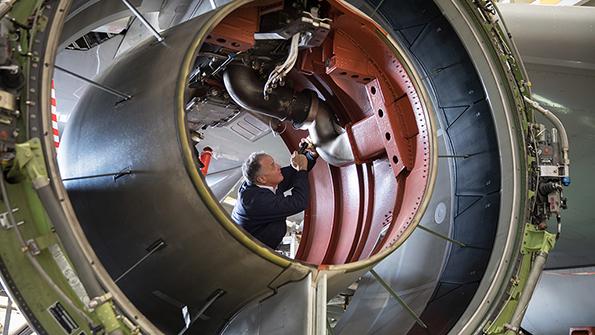
The COVID-19 crisis has caused much of Australia’s aircraft maintenance industry to grind to a halt, as companies slash operations and cut employee numbers to adjust to an increasingly dire business environment.
The survival of maintenance, repair and overhaul (MRO) companies will be essential to the recovery of Australian aviation. They have a major role to play in returning parked aircraft to operations, as well as supporting a wide range of services from airlines to agricultural aviation and firefighting. However, the country’s MRO sector is likely to be considerably smaller in the wake of the pandemic.
- Many smaller MRO operators are struggling to survive
- Companies with a diverse customer base are in better shape
Line maintenance businesses have been particularly hard-hit by the suspension of most scheduled airline flights. For example, Heston—Australia’s largest independent MRO company—usually relies on its contracts with large foreign airlines that fly to Australia. “We lost, at best estimate, some 90% of line maintenance work volume,” Heston Director Jonas Butautis says.
The sharp decline in flights into and out of Australian airports has “directly impacted” Heston, says Butautis. The company has been forced to stand down all of its employees aside from “five key positions” in its headquarters staff. There is a “minimum operational workload” from cargo and the few remaining passenger flights, so Heston deploys “a small number of engineers” depending on the need each day.
Like some other aviation companies, Heston plans to use the government’s JobKeeper wage subsidy “to the maximum possible extent” to help the company survive, Butautis says. However, he notes that Australia has “not seen a clear focused action from [federal] or state governments aimed at saving the Australian MRO industry from demise” during the coronavirus crisis.
In comparison, the U.S. and other countries “have specific measures aimed at supporting their national MRO players,” says Butautis. This means when the crisis is over, “only the MRO markets which had government support during this period will continue to grow and compete globally.”
Heston has been forced to pause its ambitious expansion strategy due to the pandemic. “Our plan is to hibernate through this period without losing our people, our customers or our certificates,” Butautis says.
However, the company is still doing what it can to support its longer-term development. Heston gained its Part 147 technical-training certificate from the Civil Aviation Safety Authority in April and is also making progress in its “engines on wing” certification. “We want to exit this nightmare period as a stronger, better-positioned company,” Butautis says.
MRO companies around the country are seeing “work dry up very quickly,” says Ken Cannane, executive director of Australia’s MRO Business Association (Amroba). The group’s members are generally small- to midsize companies, and Cannane estimates about half are “struggling to survive” due to lack of business from airlines and aircraft operators.
Many of the MRO providers have either stood down significant numbers of staff or are contemplating doing so, Cannane says. Others have closed down completely. One Amroba member recently told him their company was “almost broke and finished,” says Cannane. “And I’m getting feedback like that on a regular basis.”
Some MRO businesses are still receiving work from emergency services and other aviation users that are continuing to operate. However, a far larger proportion of Australia’s aviation industry is reliant on tourism, and this sector could take a long time to rebound.
In most economic slumps, “aviation is the first [industry] to go down and the last to come back,” Cannane says. When aircraft operators do resume flying, it could take another few months before maintenance work starts to flow to MRO businesses again.
Amroba is calling for the government to aid the industry’s recovery by reducing burdensome and costly red tape and duplication between regulatory authorities. This would help give companies the versatility they will need to adapt to the post-pandemic business environment, Cannane says.
In many cases, the larger companies with the most diversity in their operations are faring best during the pandemic. For example, TAE Aerospace, headquartered near Brisbane, has so far been able to keep all of its employees working at its facilities in Australia and in other countries. Commercial aviation MRO work has been down, but TAE has significant business in other sectors, including defense, air freight, agricultural aviation and aerial firefighting, says TAE CEO Andrew Sanderson.
TAE’s commercial aviation activity “has seen slowdowns across the board,” Sanderson says. Travel restrictions mean most engine field service trips cannot occur, although TAE is offering technical support over the phone. Reduced operations by major clients such as Qantas has also led to a drop in the wheels and brakes business. “No flying ultimately results in no wheels or brakes needing maintenance,” Sanderson notes.
Defense industry demand “is remaining quite strong” and is helping offset some of the commercial decline, Sanderson says.
The MRO divisions of the airlines themselves are also affected. Qantas has stood down two-thirds of its overall workforce due to its diminished flying schedule. While the carrier is not releasing the exact percentage for its engineering division, it is operating with a “reduced workforce” in that area, a spokesman tells Aviation Week.
Some line maintenance is still needed to support the airline’s remaining domestic flying and freight services. But most of its aircraft are parked at airports around the country. Although this has cut the engineering workload, some tasks are required on a regular basis for the grounded aircraft.
Aircraft wheels must be rotated every 1-2 weeks, either by towing the aircraft a short distance or using a jack to hoist them so the wheels can be spun, says Qantas maintenance head John Walker. Engines must also be fired up every 1-2 weeks.
Qantas’ heavy maintenance facilities in Brisbane are still open, the airline spokesman says. However, heavy maintenance checks are occurring at a much slower rate than planned since most aircraft are not accumulating flight hours.




